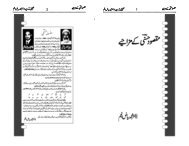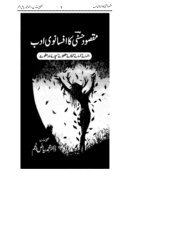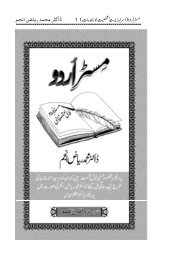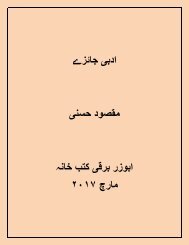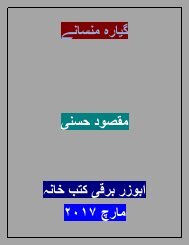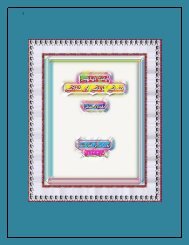Japani_ki_lisaniyati_Nazam_or_bhol_chal
You also want an ePaper? Increase the reach of your titles
YUMPU automatically turns print PDFs into web optimized ePapers that Google loves.
JPANI KA LASANIYATI NAZAAM AUR<br />
BOOL CHAL By Maqssoq Hasni<br />
132<br />
• Mizenkei shina- ina183<br />
• Renyoukei shini- ini-<br />
• Shuushikei shinu inu<br />
• Rentaikei shinuru inuru<br />
• Izenkei shinure- inure-<br />
• Meireikei shine ine<br />
Yodan / four-row verbs<br />
shinu and inu are called "na-column irregular verbs"<br />
(na-gyou henkaku<br />
katsuyou doushi ). The most common type of verbs follow a<br />
different conjugation pattern: they are called yodan doushi,<br />
"four-row verbs". Take, f<strong>or</strong> example, kaku, "to write":<br />
<strong>ki</strong> and keri:<br />
Mishi hito, "the person seen", would be mita hito in modern<br />
Japanese. It is f<strong>or</strong>med by adding the <strong>ki</strong> to the renyoukei of<br />
miru, "to see", and f<strong>or</strong>ming the rentaikei. mukashi, otoko<br />
arikeri. "Once upon a time, there was a man." - Several<br />
episodes of the Ise monogatari begins with this line. (Note<br />
that in classical Japanes aru was used f<strong>or</strong> humans as well.)<br />
-keri <strong>or</strong>iginally means past tense, it is often used only to<br />
express poetic emphasis.<br />
<strong>Japani</strong> verb/noun<br />
Compiled By: Dr. M. Riaz Anjum<br />
A<br />
Ahiru Aa hi ru domestic duck gharailo batakh<br />
Aruku aa ru ku <strong>chal</strong>na to walk<br />
B bu<br />
Buta bu ta pig<br />
C cho<br />
Chouchou Chou Chou butterfly titli<br />
Chuusha chuu sha injection tika<br />
(Yah verb bhi estamal hota hai)<br />
D de<br />
Densha den sha electric train bijli say <strong>chal</strong>nay wali rail gari<br />
E<br />
66<br />
JPANI KA LASANIYATI NAZAAM AUR<br />
BOOL CHAL By Maqssoq Hasni<br />
131<br />
Compiled By: Dr. M. Riaz Anjum<br />
Verbs can have 6 different stem f<strong>or</strong>ms, and suffices are<br />
attached to one of these. Actually, modern Japanese is just<br />
like that: take the verb yomu (to read). It has different stem<br />
f<strong>or</strong>ms, like yoma-, yome- and yomi-. Eg. the -masu suffix<br />
must be attached to the yomi- stem: to obtain the polite<br />
f<strong>or</strong>m yomimasu. The -nakatta suffix comes with the yomastem:<br />
so we obtain yomanakatta ( did not read ). And to<br />
f<strong>or</strong>m the conditional yomeba ( if [I] read ), you add the -ba<br />
suffix to the yome- stem.<br />
F<strong>or</strong> many verbs, some of the six stem f<strong>or</strong>ms are identical;<br />
actually there are only two verbs f<strong>or</strong> which all the six f<strong>or</strong>ms<br />
differ: shinu ( to die ), and inu ( to leave, to go away ).<br />
The six stem f<strong>or</strong>ms of classical Japanese are:<br />
• Izenkei - roughly c<strong>or</strong>responds to the yoma f<strong>or</strong>m: suffices<br />
that express negation are added to this stem. The izenkei<br />
of shinu is shina- Eg.<br />
shinazu ( does not die ).<br />
• Renyoukei - roughly c<strong>or</strong>responds to the yomi f<strong>or</strong>m. F<strong>or</strong><br />
shinu, the renyoukei is shini-. Eg. the -tari suffix, expressing<br />
past tense, is added to the renyoukei: shinitari.<br />
• Shuushikei - this is the dictionary f<strong>or</strong>m of verbs: shinu. It is<br />
used typically at the end of the sentence, hence the name.<br />
• Rentaikei - this f<strong>or</strong>m is used when a verb is set bef<strong>or</strong>e a<br />
noun as an<br />
adjectival modifier. F<strong>or</strong> shinu, the rentaikei is shinuru, so f<strong>or</strong><br />
example<br />
"the person who dies" would be shinuru hito. Note that in<br />
modern Japanese we would use the shuushikei instead:<br />
shinu hito. • Izenkei - F<strong>or</strong> shinu, the izenkei is shinure-. A<br />
common suffix that is added to the izenkei is -domo, which<br />
roughly c<strong>or</strong>responds to -keredo in modern Japanese.<br />
shinuredomo would be shindakeredo in modern Japanese,<br />
meaning "although [he] died..."<br />
• Meireikei - expresses the imperative. shine - "drop dead!"<br />
To summarize the six f<strong>or</strong>ms of shinu and inu (called the<br />
Na-column irregular verbs):




